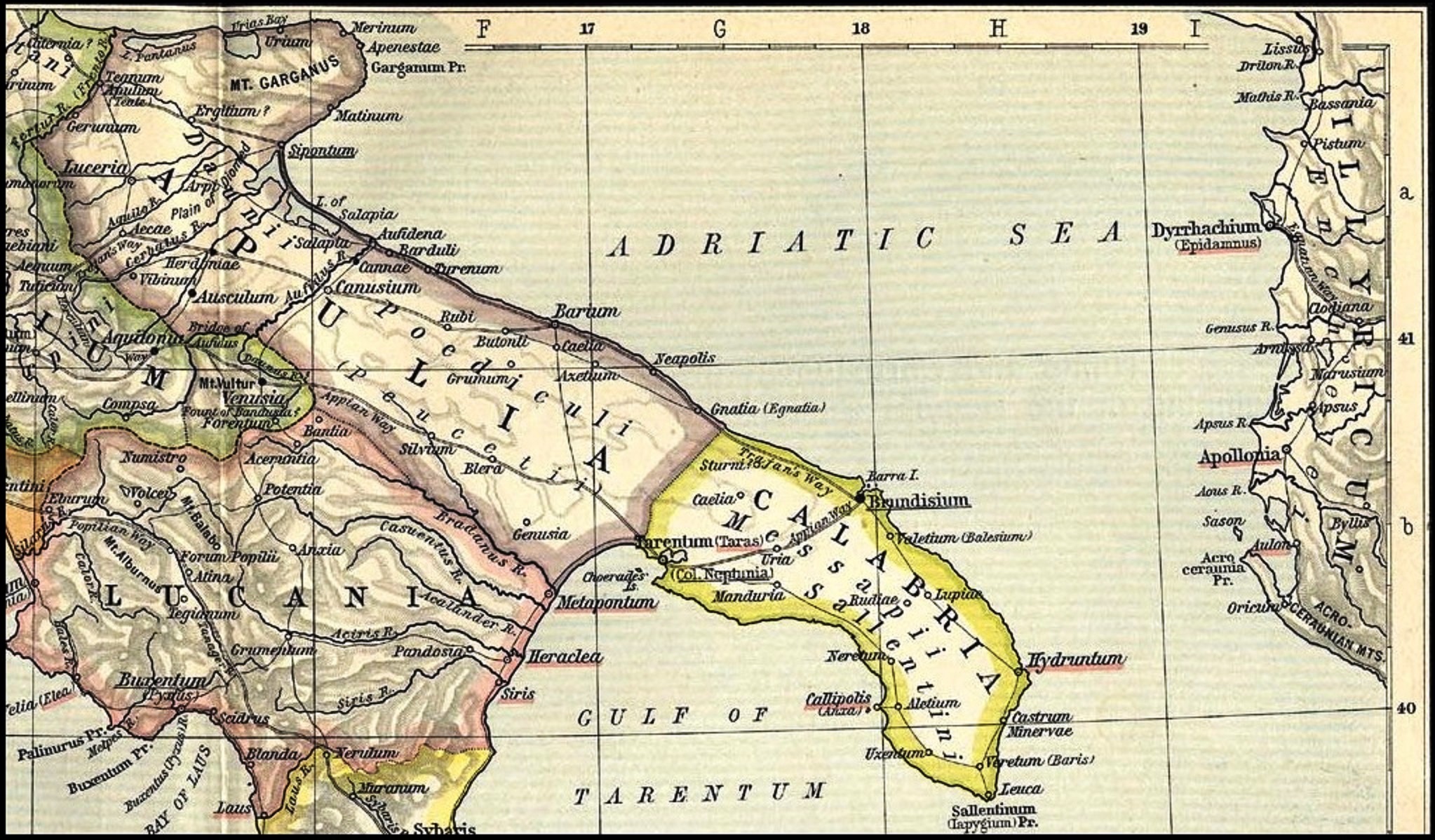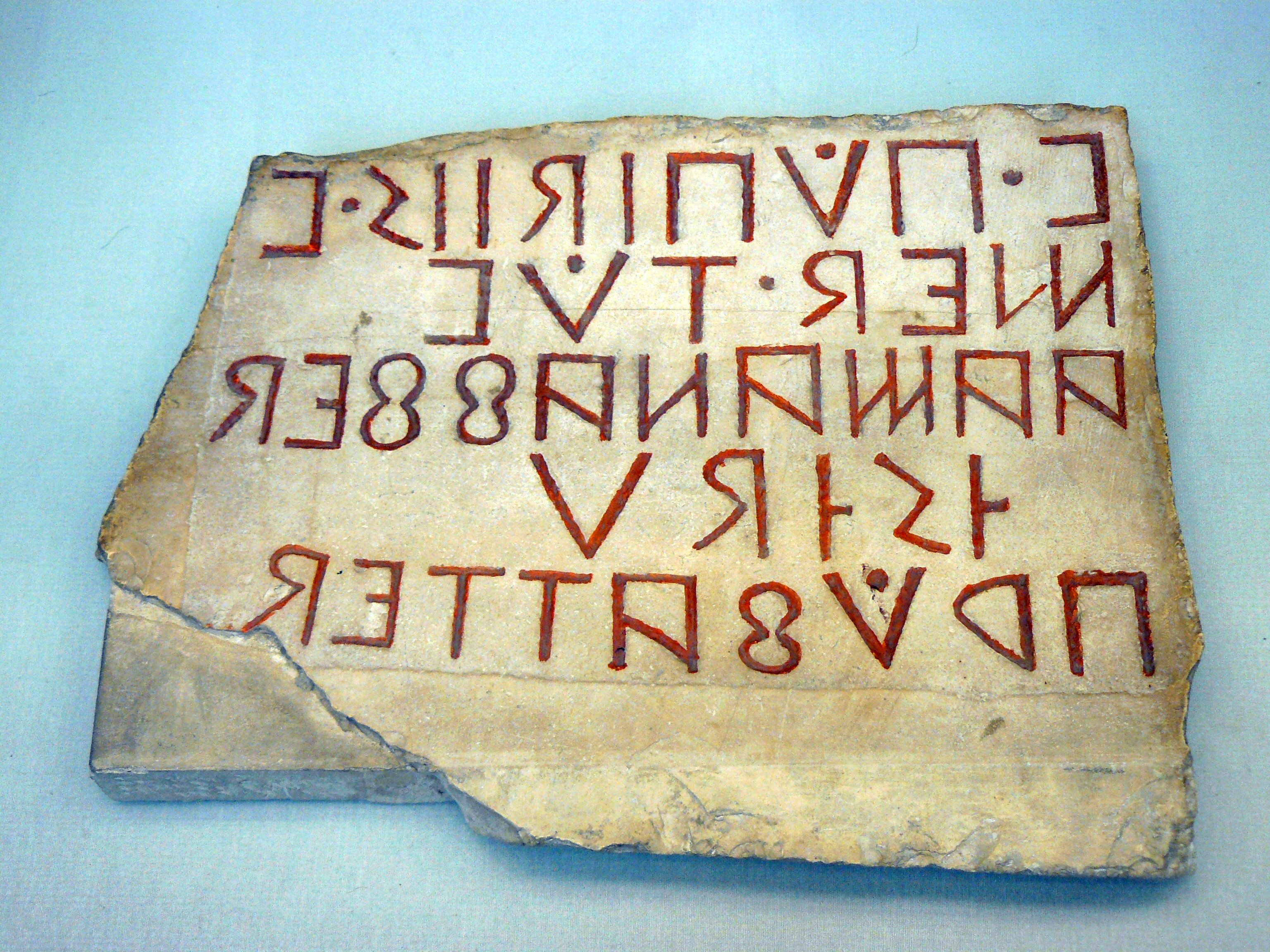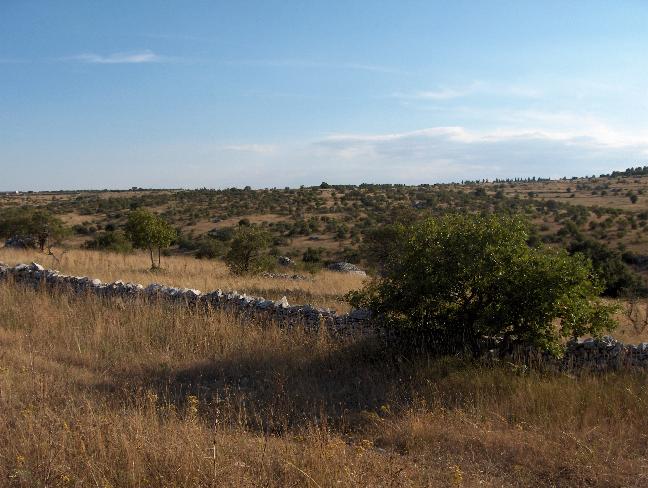|
Iapygians
The Iapygians or Apulians (; el, Ἰάπυγες, ''Ĭāpyges''; la, Iāpyges, Iapygii, Umbrian ''Iabuscer'') were an Indo-European-speaking people, dwelling in an eponymous region of the southeastern Italian Peninsula named Iapygia (modern Apulia) between the beginning of the first millennium BC and the first century BC. They were divided into three tribal groups: the Daunians, Peucetians and Messapians. After their lands were gradually colonized by the Romans from the late 4th century onward and eventually annexed to the Roman Republic by the early 1st century BC, Iapygians were fully Latinized and assimilated into Roman culture. Name The region was known to the Greeks of the 5th century BC as ''Iapygía'' (Ἰαπυγία), and its inhabitants as the ''Iápyges'' (Ἰάπυγες). It was probably the term used by the indigenous peoples to designate themselves. The name ''Iapyges'' has also been compared to that of the '' Iapydes'', an Illyrian tribe of northern Dalmat ... [...More Info...] [...Related Items...] OR: [Wikipedia] [Google] [Baidu] |
Messapic Language
Messapic (; also known as Messapian; or as Iapygian) is an extinct Indo-European language of the southeastern Italian Peninsula, once spoken in Apulia by the Iapygian peoples of the region: the ''Calabri'' and ''Salentini'' (known collectively as the Messapii), the Peucetians and the Daunians. Messapic was the pre- Roman, non- Italic language of Apulia. It has been preserved in about 600 inscriptions written in an alphabet derived from a Western Greek model and dating from the mid-6th to at least the 2nd century BC, when it went extinct following the Roman conquest of the region. Name The term 'Messapic' or 'Messapian' is traditionally used to refer to a group of languages spoken by the Iapygians, a "relatively homogeneous linguistic community" of non- Italic-speaking tribes ( Messapians, Peucetians and Daunians) dwelling in the region of Apulia before the Roman conquest. However, some scholars have argued that the term ' Iapygian languages' should be preferred for ... [...More Info...] [...Related Items...] OR: [Wikipedia] [Google] [Baidu] |
Daunians
The Daunians ( el, Δαύνιοι, Daúnioi; la, Daunii) were an Iapygian tribe that inhabited northern Apulia in classical antiquity. Two other Iapygian tribes, the Peucetians and the Messapians, inhabited central and southern Apulia respectively. All three tribes spoke the Messapic language, but had developed separate archaeological cultures by the seventh century BC. The Daunians lived in the Daunia region, which extended from the Daunian Mountains river in the southeast to the Gargano peninsula in the northwest. This region is mostly coincident with the Province of Foggia and part of Province of Barletta-Andria-Trani today. Daunians and Oscans came into contact in northern Daunia and southern Samnite regions. Gradually, parts of northern Daunia became "Oscanized". Name The ethnonym is connected to the name of the wolf, plausibly the totemic animal of this nation. The cult of the wolf was widespread in ancient Italy and was related to the Arcadian mystery cult. ''Dauno ... [...More Info...] [...Related Items...] OR: [Wikipedia] [Google] [Baidu] |
Apulia
Apulia ( ), also known by its Italian name Puglia (), :: nap, label=, Puie :: nap, label=Tarantino dialect, Tarantino, Puje : scn, label=Salentino dialect, Salentino, Puia : frp, label=Faetar language, Faetar, Poulye : el, label=Griko language, Griko, Απουλία : aae, Pulia. is a Regions of Italy, region of Italy, located in the Southern Italy, southern peninsular section of the country, bordering the Adriatic Sea to the east, the Ionian Sea to the southeast and the Strait of Otranto and Gulf of Taranto to the south. The region comprises , and its population is about four million people. It is bordered by the other Italian regions of Molise to the north, Campania to the west, and Basilicata to the southwest. Its chief town is Bari. Geography Apulia's coastline is longer than that of any other mainland Italian region. In the north, the Gargano promontory extends out into the Adriatic sea like a 'sperone' ("spur"), while in the south, the Salento peninsula forms the 'tacc ... [...More Info...] [...Related Items...] OR: [Wikipedia] [Google] [Baidu] |
Apulia Calabria Et Lucania - Shepherd-c-030-031
it, Pugliese , population_note = , population_blank1_title = , population_blank1 = , demographics_type1 = , demographics1_footnotes = , demographics1_title1 = , demographics1_info1 = , demographics1_title2 = , demographics1_info2 = , demographics1_title3 = , demographics1_info3 = , timezone1 = CET , utc_offset1 = +01:00 , timezone1_DST = CEST , utc_offset1_DST = +02:00 , postal_code_type = , postal_code = , area_code_type = ISO 3166 code , area_code = IT-75 , blank_name_sec1 = GDP (nominal) , blank_info_sec1 = €76.6 billion (2018) , blank1_name_sec1 = GDP per capita , blank1_info_sec1 = €19,000 (2018) , blank2_name_sec1 = HDI (2018) , blank2_info_sec1 = 0.845 · 18th of 21 , blank_name_sec2 = NUTS Region , blank_info_sec2 ... [...More Info...] [...Related Items...] OR: [Wikipedia] [Google] [Baidu] |
Messapians
The Messapians ( grc, Μεσσάπιοι, Messápioi; la, Messapii) were a Iapygian tribe who inhabited Salento in classical antiquity. Two other Iapygian tribes, the Peucetians and the Daunians, inhabited central and northern Apulia respectively. All three tribes spoke the Messapian language, but had developed separate archaeological cultures by the seventh century BC. The Messapians lived in the eponymous region Messapia, which extended from Leuca in the southeast to Kailia and Egnatia in the northwest, covering most of the Salento peninsula. This region includes the Province of Lecce and parts of the provinces of Brindisi and Taranto today. Starting in the third century BC, Greek and Roman writers distinguished the indigenous population of the Salento peninsula differently. According to Strabo, the names ''Iapygians'', ''Daunians'', ''Peucetians'' and ''Messapians'' were exclusively Greek and not used by the natives, who divided the Salento in two parts. The southern ... [...More Info...] [...Related Items...] OR: [Wikipedia] [Google] [Baidu] |
Peucetians
The Peucetians ( grc, Πευκέτιοι, Peukétioi; la, Peucetii; later also grc, Ποίδικλοι, Poidikloi, links=no; la, Poediculi, links=no) were an Iapygian tribe which inhabited western and central Apulia in classical antiquity. Two other Iapygian tribes, the Daunians and the Messapians, inhabited northern and southern Apulia respectively. All three tribes spoke the Messapian language, but had developed separate archaeological cultures by the seventh century BC; however, in Peucetian territory ancient Greek and Oscan language were spoken as well, as the legends of the currencies from Rubi and Azetium were trilingual. Peucetians lived in the eponymous region Peucetia, which was bordered by the Ofanto river and the Murge in the north, the Bradano river in the west and the territories of the Greek colony of Taras and the Messapians in the south. This region is mostly coincident with the Metropolitan City of Bari and parts of the provinces of Taranto and Barlett ... [...More Info...] [...Related Items...] OR: [Wikipedia] [Google] [Baidu] |
Salento
Salento ( Salentino: ''Salentu'', Salentino Griko: ''Σαλέντο'') is a cultural, historical and geographic region at the southern end of the administrative region of Apulia in Southern Italy. It is a sub-peninsula of the Italian Peninsula, sometimes described as the "heel" of the Italian "boot". It encompasses the entire administrative area of the province of Lecce, a large part of the province of Brindisi and part of that of Taranto. The peninsula is also known as Terra d'Otranto, and in the past Sallentina. In ancient times it was called variously Calabria or Messapia. History Messapia (from Greek ''Μεσσαπία'') was the ancient name of a region of Italy largely corresponding to modern Salento. It was inhabited chiefly by the Messapii in classical times. Pokorny derives the toponym from the reconstructed PIE ''*medhyo-'', "middle" and PIE ''*ap-'', "water" (''Mess-apia'', "amid waters"). Pokorny compares the toponym ''Messapia'' to another ancient Italic ... [...More Info...] [...Related Items...] OR: [Wikipedia] [Google] [Baidu] |
Oscan Language
Oscan is an extinct Indo-European language of southern Italy. The language is in the Osco-Umbrian or Sabellic branch of the Italic languages. Oscan is therefore a close relative of Umbrian. Oscan was spoken by a number of tribes, including the Samnites, the Aurunci (Ausones), and the Sidicini. The latter two tribes were often grouped under the name " Osci". The Oscan group is part of the Osco-Umbrian or Sabellic family, and includes the Oscan language and three variants ( Hernican, Marrucinian and Paelignian) known only from inscriptions left by the Hernici, Marrucini and Paeligni, minor tribes of eastern central Italy. Adapted from the Etruscan alphabet, the Central Oscan alphabet was used to write Oscan in Campania and surrounding territories from the 5th century BCE until possibly the 1st century CE. Evidence Oscan is known from inscriptions dating as far back as the 5th century BCE. The most important Oscan inscriptions are the Ta ... [...More Info...] [...Related Items...] OR: [Wikipedia] [Google] [Baidu] |
Samnites
The Samnites () were an ancient Italic people who lived in Samnium, which is located in modern inland Abruzzo, Molise, and Campania in south-central Italy. An Oscan-speaking people, who may have originated as an offshoot of the Sabines, they formed a confederation consisting of four tribes: the Hirpini, Caudini, Caraceni, and Pentri. Although allied together against the Gauls in 354 BC, they later became enemies of the Romans and fought them in a series of three wars. Despite an overwhelming victory at the Battle of the Caudine Forks (321 BC), the Samnites were subjugated in 290 BC. Although severely weakened, the Samnites would still side against the Romans, first in the Pyrrhic War and then with Hannibal in the Second Punic War. They also fought in the Social War and later in Sulla's civil war as allies of the Roman consuls Papirius Carbo and Gaius Marius against Sulla, who defeated them and their leader Pontius Telesinus at the Battle of the Colline Gate (82 BC ... [...More Info...] [...Related Items...] OR: [Wikipedia] [Google] [Baidu] |
Altopiano Delle Murge
The Altopiano delle Murge ( Italian for "Murge plateau") is a karst topographic plateau of rectangular shape in southern Italy. Most of it lies within Apulia and corresponds with the sub-region known as Murgia or Le Murge. The plateau lies mainly in the Metropolitan City of Bari and the province of Barletta-Andria-Trani, but extends into the provinces of Brindisi and Taranto to the south, and into Matera in Basilicata to the west. The name is believed to originate from the Latin ''murex'', meaning "sharp stone". Geography and geology The Murge plateau covers a surface of some 4,000 km², bordered by the Ofanto river and the Tavoliere delle Puglie to the north, the Adriatic Sea to the northeast, and by the Messapic depression, which separates it from the Salento peninsula, to the south. It is usually divided into Alta Murgia (High Murgia), the highest area, with poorer vegetation, and Bassa Murgia (Lower Murgia), with more fertile land, extensively planted with olive-tr ... [...More Info...] [...Related Items...] OR: [Wikipedia] [Google] [Baidu] |
Taranto
Taranto (, also ; ; nap, label=Tarantino dialect, Tarantino, Tarde; Latin: Tarentum; Old Italian: ''Tarento''; Ancient Greek: Τάρᾱς) is a coastal city in Apulia, Southern Italy. It is the capital of the Province of Taranto, serving as an important commercial port as well as the main Italian naval base. Founded by Spartans in the 8th century BC during the period of Greek colonisation, Taranto was among the most important in Magna Graecia, becoming a cultural, economic and military power that gave birth to philosophers, strategists, writers and athletes such as Archytas, Aristoxenus, Livius Andronicus, Heracleides of Tarentum, Heracleides, Iccus of Taranto, Iccus, Cleinias of Tarentum, Cleinias, Leonidas of Tarentum, Leonidas, Lysis of Taras, Lysis and Sosibius of Tarentum, Sosibius. By 500 BC, the city was among the largest in the world, with a population estimated up to 300,000 people. The seven-year rule of Archytas marked the apex of its development and recognition of i ... [...More Info...] [...Related Items...] OR: [Wikipedia] [Google] [Baidu] |
Magna Graecia
Magna Graecia (, ; , , grc, Μεγάλη Ἑλλάς, ', it, Magna Grecia) was the name given by the Romans to the coastal areas of Southern Italy in the present-day Italian regions of Calabria, Apulia, Basilicata, Campania and Sicily; these regions were extensively populated by Greek settlers. These settlers, who began arriving in the 8th century BC, brought with them their Hellenic civilization, which left a lasting imprint on Italy (such as in the culture of ancient Rome). They also influenced the native peoples, such as the Sicels and the Oenotrians, who became hellenized after they adopted the Greek culture as their own. The Greek expression ''Megálē Hellás'', later translated into Latin as ''Magna Graecia,'' first appears in Polybius' ''Histories,'' where he ascribed the term to Pythagoras and his philosophical school. Strabo also used the term to refer to the size of the territory that had been conquered by the Greeks, and the Roman poet Ovid used the term ... [...More Info...] [...Related Items...] OR: [Wikipedia] [Google] [Baidu] |



.jpg)




